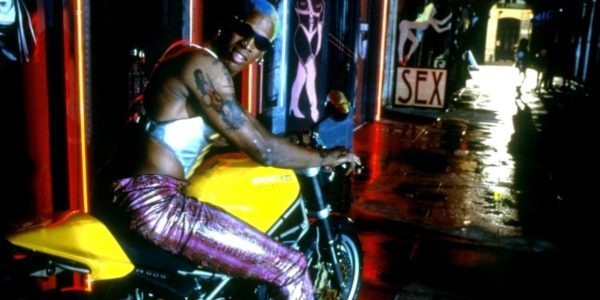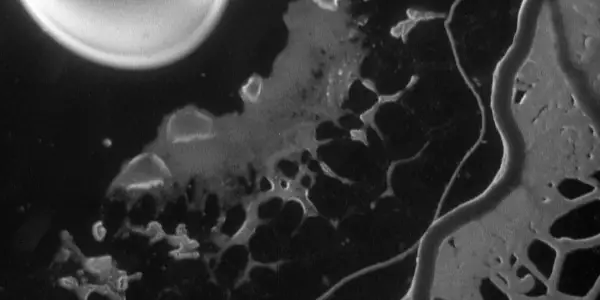Video Dispatches: JCVD x2, HEROES SHED NO TEARS & MINUTE BODIES

Midwesterner, movie lover, cinnamon enthusiast.
Video Dispatches is a regular column covering recent home video releases.
Double Impact (1991) – MVD Rewind Collection

In 1991, three years after Jeremy Irons played a set of twin brothers in Dead Ringers and more than 50 years after Edward G. Robinson shared scenes with himself in The Whole Town’s Talking, Jean-Claude Van Damme got his chance to play opposite himself in Sheldon Lettich ’s Double Impact, an action film about twin brothers reunited as adults avenging the murder of their father, who was killed by a Hong Kong crime boss.
Desson Thomson opened his Washington Post review with a call-and-response: “What’s worse than a Jean-Claude Van Damme movie? Two Jean-Claude movies. What’s worse than that? One movie with two Jean-Claudes in it.” But as New York Times critic Caryn James posited, “As it turns out, two Jean-Claude Van Dammes are pretty much the same as one.” When the film’s plot begins to thicken, it blurs the line that distinguishes Van Damme’s two brothers. Whichever one’s on screen, he’s doing some kicking, punching, shooting or, in one scene, some f*cking — shot in hyper-neon soft-core slow-mo.
Most of the action doesn’t surpass adequate save for one shootout that allows Van Damme to roll around a warehouse with dueling pistols that made me want to one-day ship some G.I. Joes. Of course, that’s ultimately what Double Impact is — male wish fulfillment; an excuse to get this action hunk in a warehouse, boiler room or international port.
MVD have previously released Van Damme hits Lionheart and Black Eagle, but according to Under the Radar, this release far outdoes those past (and respectable) efforts (which I have not checked out). That’s not surprising considering the exhaustive inclusions here, including a newly filmed two-part, two-hour documentary detailed the film’s making. With updated interviews with Van Damme and director Sheldon Lettich (among others), this is obviously the filet of the supplements, but I also enjoyed the archival behind the scenes piece.
MVD have also included a new “Anatomy of a Scene” with Lettich talking over the film’s third-act chase scene, which follows Van Damme and Alonna Shaw jumping from boat to boat on the Aberdeen Harbour. The extra is pretty slight and has Lettich saying stuff like, “People were actually living on these boats. We probably paid those people to film on them.” But overall, what MVD did with this package is pretty remarkable; sadly, we don’t expect this type of comprehensive home video work to be done with films like Double Impact.
Double Team (1997) – Mill Creek Entertainment

Mill Creek’s release of Tsui Hark ’s return to Hollywood, Double Team, offers an interesting dialogue when paired with MVD’s release of Double Impact: a more complete Van Damme action outing in a totally non-comprehensive package. As is Mill Creek’s business model, Double Team is offered bare-bones, but will also be priced appropriately, which is much more than can be said for many other labels’ business model.
Thankfully, Double Team is enough on its own to warrant a purchase of this Blu-ray, which doesn’t look shabby at all. The film is a series of go-for-broke set pieces that only stops for dumb Dennis Rodman gags and wardrobe changes and some silly pre-Y2K cyber monkeying. Most action films can’t muster a climax that sniffs at what Hark achieves in the opening 20 minutes of Double Team. And then there’s the actual climax, taking place in an ancient European coliseum and pits Van Damme and Rodman against Mickey Rourke, land mines and a tiger and ends with Rodman staving off a fiery death by hiding behind a Coca-Cola machine. At 93 minutes and a low price-point, this cheap thrill comes highly recommended.
Heroes Shed No Tears (1986) – Film Movement

Heroes Shed No Tears, John Woo ’s film about Chinese mercenaries sent to Thailand to overthrow a drug lord, can be considered the urtext of his most widely considered work. The project pulled him out of comedy purgatory and allowed him an opportunity to discover an action cinema style that would continue to flamboyantly blossom in the following decade.
This film isn’t his breakthrough, which was A Better Tomorrow, but it was hidden from audiences until that film was released. Heroes Shed No Tears is pure exploitation, all shootouts and explosions that only stop for a few tender moments of father-son non-verbal communication, a ludicrous sex scene and some goofball gambling — the latter two elements were made and edited in beyond Woo’s efforts and wishes. Though flawed, it’s a genuinely good time at the movies, and one that doesn’t overstay its welcome.
Film Movement have put together a really nice package for this. Primarily, they’ve released a new 2K restoration that looks lovely. Additionally, there’s a nice booklet essay from Grady Hendrix, who’s able to supplement the film with context, informative trivia and articulations like, “Woo hasn’t emerged from his cocoon as a beautiful, ballistic butterfly yet, but Heroes is definitely his teething ring.” The newly filmed interview with Eddy Ko is also noteworthy. He talks about his career, the multicultural set of Heroes Shed No Tears and gives insight into Woo’s insistence on using live ammunition.
Minute Bodies (2016) – Icarus Films

The year 2016 saw two films distinctly made in tribute to silent cinema, Bill Morrison ’s Dawson City: Frozen Time and Stuart A. Staples ’s Minute Bodies. Morrison’s film, released earlier this year, was part of a career-length project of refashioning, remixing and reviving silent cinema, generally, while Staples, who’s better known as the frontman of the indie band Tindersticks, made a film in specific homage to the works of F. Percy Smith, a silent filmmaker who primarily photographed elements of nature.
Both films also commissioned original instrumental music from artists in the relatively indie music scene — Staples, of course, creating a soundtrack with his band, and Morrison using new music from Alex Sommers of Sigur Ros. However, Dawson City, which is twice the length of Minute Bodies, is a complete, self-contained work buttressed by its moving soundtrack, while Staples’ film feels more like the type of screen work projected behind indie bands during shows. It’s certainly not a strain to get through, but I attributed that to Smith’s expressive work on display.
As slight as Minute Bodies may be, I’m thankful for Staples on the basis that his film offers more exposure of one of early cinema’s important artists. And further, I’m thankful that Icarus has taken the opportunity with this release to supplement Staples’ film with four short films photographed by Smith and edited by his frequent collaborator Mary Field, who unfortunately gets no mention in this package.
Does content like this matter to you?
Become a Member and support film journalism. Unlock access to all of Film Inquiry`s great articles. Join a community of like-minded readers who are passionate about cinema - get access to our private members Network, give back to independent filmmakers, and more.













